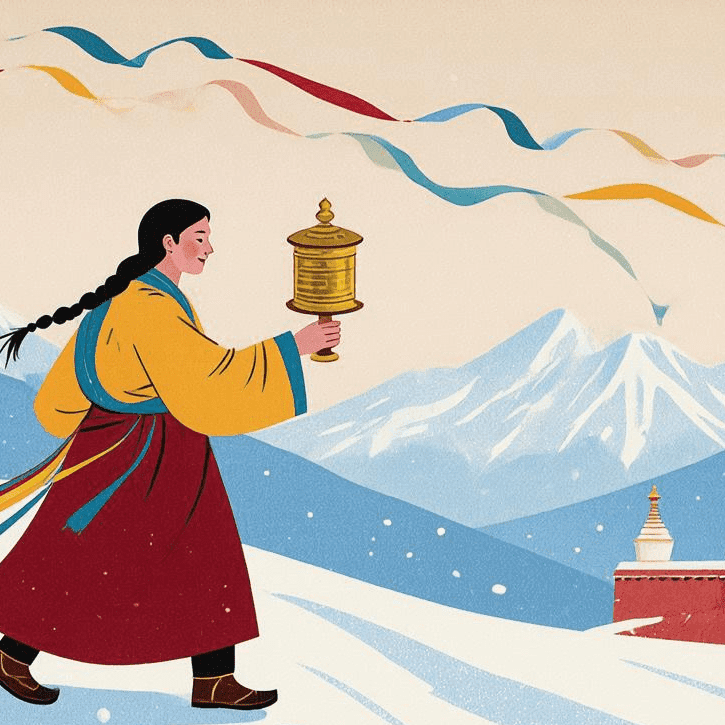Spinning Tradition: The Ancient Charm of the Tibetan Prayer Wheel

Opening Hook:
Imagine strolling through a vibrant market abroad – maybe Marrakech, Istanbul, or a bustling festival in Berlin. Among colourful carpets and spices, a glint of metal catches your eye. It’s a fascinating cylinder, adorned with intricate symbols and spinning effortlessly on its handle. You’ve just discovered a Tibetan Buddhist Prayer Wheel (转经筒, Zhuànjīngtǒng), an ancient treasure weaving spirituality with art. But did you know this object whispers tales of profound philosophy passed down through centuries across the stunning landscapes of the Himalayas?
The Legend Spins to Life:
Our journey starts over a thousand years ago, deep within the evolving landscape of Tibetan Buddhism, an integral and vibrant part of China’s diverse cultural tapestry. The exact inventor’s name is lost in the mists of time, blending history with legend. However, the purpose shines clearly: to make sacred Buddhist practices accessible to everyone.
The core idea? Inside the wheel’s cylinder traditionally rests a tightly rolled scroll inscribed with millions of repetitions of a central Buddhist mantra: “Om Mani Padme Hum.” This powerful phrase encapsulates compassion and wisdom – core values resonant even today. Ancient masters had a beautiful insight: spinning this cylinder – setting the written prayers within in motion – was considered spiritually equivalent to verbally reciting those countless mantras. It became a tangible way for people to engage with profound spiritual concepts amidst daily life, whether walking, working, or meditating.
Why Craftsmanship Matters: The Heartbeat in Metal & Wood:
These prayer wheels are far more than simple religious objects; they are exquisite expressions of Himalayan artistry and devotion. Historically crafted by skilled Tibetan artisans, the wheels reflect deep respect for the tradition they represent:
-
Material Poetry: Made from brass, copper, or carved wood, often ornamented with sacred symbols like the endless knot, lotus flower, or auspicious cloud patterns.
-
Silk & Stone Accents: Colourful silk ribbons dance from the handle, each representing a blessing. The top is often crowned by a spinning finial symbolizing compassion, or adorned with semi-precious stones like turquoise or coral – deeply valued in Himalayan culture.
-
Engraved Wisdom: The outside cylinder is often meticulously engraved with Sanskrit or Tibetan script characters – mantras or blessings themselves.
Bringing the Mountain Spirit Home: Your Prayer Wheel as Cultural Artefact:
This profound tradition now spins its way onto shelves and altars worldwide. Why is owning an authentic prayer wheel such a unique experience?
-
A Slice of Sacred Landscape: It connects you to the breathtaking mountains, monasteries, and resilient culture of Tibet. It’s a piece of living heritage crafted with techniques passed down generations.
-
Mindfulness Made Tangible: The gentle, rhythmic motion of spinning the wheel offers a physical anchor. It’s a simple, beautiful tool for calming the mind, reducing stress, and inviting a moment of mindful presence. Spin it slowly as you breathe deeply. Feel the weight, admire the craftsmanship.
-
Symbolism That Speaks: Representing compassion, wisdom, and the turning of existence itself, it’s a powerful universal emblem – not requiring adherence to Buddhism to appreciate its message of peace and interconnectedness.
-
Stunning Soulful Decor: Beyond its spiritual roots, the intricate metalwork, vibrant colours, and unique form make it a captivating centrepiece. It sparks conversations and adds undeniable character infused with ancient meaning. It’s art with a story.
Finding Your Own ‘Mani Wheel’:
When seeking an authentic prayer wheel abroad, look for sellers passionate about preserving cultural craft. They should detail:
-
Material & Origin: (E.g., “Handmade in China by Tibetan artisans using traditional brass casting methods” – authenticates cultural origin without political emphasis).
-
Symbolic Details: Understanding the engravings or symbols adds deeper appreciation.
-
Ethical Craftsmanship: Supporting artisans directly or through fair-trade practices ensures this beautiful tradition thrives.




This prayer wheel has become my sanctuary in motion. Holding its solid brass weight feels like cradling Himalayan mountains – cool, ancient, yet alive. Spinning it releases more than mantras; it unwinds my urban stress with every smooth rotation. The engraved ‘Om Mani Padme Hum’ isn’t just script; turning it becomes a tactile meditation, my fingertips tracing compassion into existence.
I’m awestruck by the craftsmanship. The turquoise-studded finial spins like a tiny galaxy, while silk ribbons dance like mountain prayers caught mid-flight. Placed on my desk, it transforms rush-hour chaos into sacred space. Visitors pause, drawn by its presence – some recognize its wisdom, others simply feel its serene energy.
More than decor, it’s a bridge. When my mind races, spinning it grounds me instantly. That soft whirring? A thousand-year-old lullaby for the soul. Knowing it’s ethically sourced from Tibetan artisans makes each rotation an act of cultural preservation.
For seekers of mindful moments and guardians of vanishing traditions: this isn’t an object. It’s a revolution of stillness, hand-cast in brass and blessed by time.